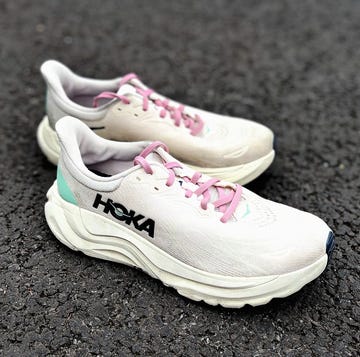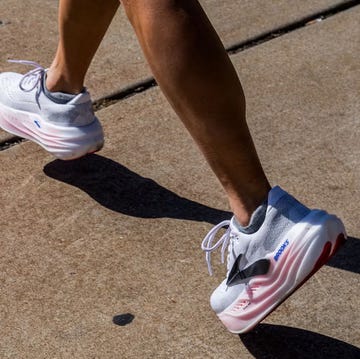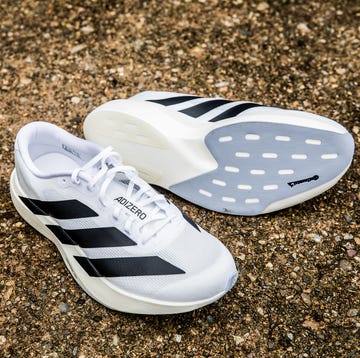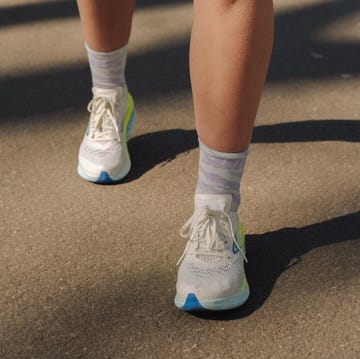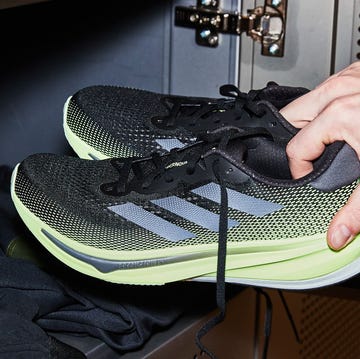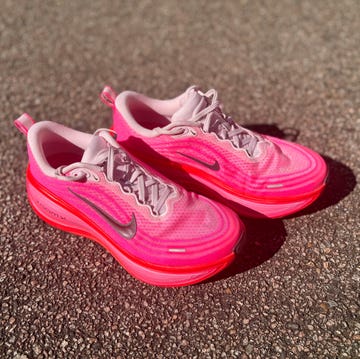- Weight: 170g (UK 8)
- Stack height: 40mm (heel), 32mm (forefoot)
- Heel-to-toe drop: 8mm
- Tester details: 161cm/50kg/neutral gait/midfoot striker
The shoe
We often get excited about the release of new running shoes – that’s a given. But I haven’t felt shoe-induced palpitations like this for a long time. Why? Because Puma has just unveiled its fastest, lightest, most responsive and arguably most attractive running shoe of all time – a shoe so well-designed for speed that even science suggests that it’ll get you a new PB. The shoe in question? The Fast-R Nitro Elite 3.
What everyone's reading
Unveiled today (Thursday 17 April), the Fast-R Nitro Elite 3 promises a significant speed advantage for marathon runners – especially those at the quicker end of the field. In fact, as per new research conducted on the shoe by the University of Massachusetts, Amherst, the Fast-R Nitro Elite 3 provides 3.15% improved running economy compared with its predecessor, the Fast-R Nitro Elite 2. I’ll explain the context and importance of this running economy figure in a moment. But for now, I’ll just say this: a 3.15% improvement in running economy, for a three-hour marathon runner, translates to a marathon time saving of more than four minutes and 30 seconds.
The shoe’s first big outings will be the 2025 Boston Marathon – which, at the time of writing, will take place next Monday (21 April) – and the 2025 London Marathon, which will be staged on Sunday 27 April. On both occasions, this shoe will be worn by elite Puma athletes, as well as 200 amateur marathoners – 100 at each race – who are members of Puma’s innovative Project3 programme. A first-of-its-kind initiative, Project3 has given these amateurs, who can each run a sub-3:10 marathon, the rare opportunity to experience life as professional athletes during their Boston and London journeys. This has involved tapping into experts for top tips on training, nutrition and mental resilience, as well as exclusive early access to Puma’s latest gear – including the Fast-R Nitro Elite 3.
Fortunately, I am one of the 100 Project3 runners building up to this year’s London Marathon, which has meant the delicious chance to clock around 90 training miles in the Fast-R Nitro Elite 3 already. It also means that this is the shoe that I’ll be wearing on race day.
In addition to forming my own thoughts, I spoke with industry specialist Wouter Hoogkamer, who led the recent study on the shoe, to better understand the statistics that make the Fast-R Nitro Elite 3 stand out from the super shoe crowd. So, let’s kick things off.
The science
To quantify the Fast-R Nitro Elite 3’s abilities, Hoogkamer and his research team took it to the lab. Specifically, they tested the speed of this shoe versus that of three other leading super shoe models: the Nike Alphafly 3, the Adidas Adizero Adios Pro Evo 1 and, as a control, to highlight the differences between one iteration and the next, Puma’s own Fast-R Nitro Elite 2.
The test saw 15 participants run in each of the four shoes for five minutes at a time, twice over and at the same speed throughout, on the same day and on the same treadmill. Eight of these participants were men who ran at a speed of 6:00 min/mile, which is roughly 16 kilometres per hour, while four women and three men ran at a speed of 7:00 min/mile, which equates to 14 kilometres per hour.
While they ran, these participants were hooked up to a machine which measured their oxygen consumption and carbohydrate production and, as a result, determined their running economy in each shoe. The better your running economy, the faster you’ll be able to run with your current physiological capacities – so if a shoe can improve your running economy, it’ll help you to hit faster paces at the same effort. Win.
This is easy for me to picture, as I was able to do my own running economy test in Puma’s Nitro Lab at its North American HQ, just outside of Boston, last year. Here, I tested the Deviate Nitro Elite 3 – another Puma super shoe – against a competitor shoe that I’d worn to achieve my then-marathon PB. According to the results, the Deviate Nitro Elite 3 was 0.46% more economical for me than the competitor, making it the winner by a whisker. For a sense of scale, a shoe is only really considered to be more economical than another if the difference between them is 0.5% or above.
That’s why the Fast-R Nitro Elite 3’s test results are so remarkable. As mentioned earlier, this shoe was found to be 3.15% more economical than its predecessor, the Fast-R Nitro Elite 2. That’s an immense improvement – but not the end of the story. According to this latest study’s findings, the Fast-R Nitro Elite 3 also offers running economy improvements of 3.54% and 3.62% versus the Adidas Adizero Adios Pro Evo 1 and Nike Alphafly 3, respectively.
‘It was intriguing to see that the Fast-R Nitro Elite 2 was already up there with the Nike and Adidas models,’ says Hoogkamer, an assistant professor at the University of Massachusetts, Amherst, who has been studying running shoes intensively for the past decade. ‘But it was even more exciting for us to see that everybody involved in the test had their best [running economy] numbers in the Fast-R Nitro Elite 3. It’s not unprecedented – but we basically haven’t seen figures and variations like this since we first introduced super shoes.
‘In 2017, we were working on a similar study which found that super shoes were 4% better, consistently, than traditional flat running shoes,’ continues Hoogkamer. ‘Some people were 2% better in super shoes, while others were 6% better – either way, we found that everybody was better in them. But then, when people started conducting studies on super shoes alone, we’ve seen that the differences have been a lot smaller. People tend to find no more than a 1.5% difference between one super shoe model and another.
‘We are essentially there with super shoes now – we know how they work and sort of play within that,’ adds Hoogkamer. ‘That’s why it’s so exciting that this shoe [the Fast-R Nitro Elite 3], which doesn’t necessarily look or feel that much different to all the other shoes out there, is way beyond the 1.5% that we’ve seen as a maximum variation between super shoes over the past five years. We’re talking more than 3% here – it’s massive.’
What’s new about the Fast-R Nitro Elite 3?
The lab data suggests that the Fast-R Nitro Elite 3 is noticeably faster than the 2 – and that’s thanks to some meaty changes.
The dramatic weight loss is the first thing to note here. The Fast-R Nitro Elite 3 feels more like a feather than footwear, coming in at just 170g for a UK 8. This is a hefty 95g reduction (which is more than half of the weight of the shoe itself) on its predecessor, the Fast-R Nitro Elite 2, which comes in at 265g for a UK 8.
With the Fast-R Nitro Elite 3, we’ve also lost the ‘fin’ at the back – a seemingly redundant feature in the second edition – and the two hanging loops attached to the tongue and heel. Who needs that extra weight, anyway? In addition, the decoupled midsole is now much less pronounced and the full-length carbon plate – or PWRPLATE – is no longer exposed in the middle, so we’re not at risk of getting stones or such like lodged between the plate and midsole. In my opinion, the Fast-R Nitro Elite 3 is a much better looking shoe, too.
However, the height of the shoe has not been altered. We still have 40mm in the heel – which is the maximum legal limit for road running shoes in official competitions, as per World Athletics rules – and 32mm in the forefoot, giving a drop of 8mm. Puma has also retained the super-responsive NITROFOAM ELITE technology in the midsole, as well as the ‘sticky-out’ Fast-R silhouette, involving a unique extension beyond the forefoot to really emphasise that toe-off.
How does the Fast-R Nitro Elite 3 fit?
I wear a women’s UK size 6 and this shoe fits true to size. In fact, my sizing is consistent between Puma models, from super shoes to stability shoes, which certainly makes things easier. For me, at least, there’s no ‘half-a-size-up’ procedure that I need to remember when opting for ‘faster’ shoes from this brand. (If only I could say the same for Nike and New Balance.)
Before you even touch it, you only need to look at the shoe to know that it’s light – the ULTRAWEAVE upper is basically translucent. Due to its slightly-plasticky sheen, I feared that this ULTRAWEAVE upper would start to rub after a few miles, or struggle to map onto the contours of my foot. Thankfully, though, these initial thoughts were unfounded – the upper material, which extends to the tongue, is amazingly soft and wraps around my foot like cling film, without the stickiness. It’s also highly breathable and surprisingly durable, which isn’t bad when you consider that I’ve already run about 150km in my pair already. According to Puma, the lifespan of the Fast-R Nitro Elite 3 is 300km (or 200 miles), so I’m still only halfway there by these standards.
Despite being bare-bones up top, this shoe is still amply cushioned around the collar and features a plush, slightly squishy insole, which your feet will appreciate over a longer distance like a marathon. It also features my favourite outsole of all time, PUMAGRIP, which delivers serious traction to keep you stable on even the slipperiest of surfaces.
A key thing to note is that this is a slim shoe. I have a slightly narrower foot, hence why I’ve had no issues – those with wide feet, however, might experience some difficulty.
What’s it like to run in the Fast-R Nitro Elite 3?
The numbers say that this shoe is fast. But is it fast in practice, too?
To be honest, before I started testing this shoe a few weeks ago, I was a little apprehensive. Puma’s Fast-R Nitro Elite family of shoes has typically been suited to runners who take longer strides and roll through the whole of their foot when they hit the ground, from heel to toe. This doesn’t align brilliantly with my own biomechanics, as I’m more of a ‘quick stepper’ with a higher cadence rather than a loping stride. This is why I’ve always opted for Puma’s other family of super shoes, the Deviate Nitro Elite, which is better tailored to my running style as a midfoot striker who appreciates a sharper rocker geometry at the forefoot.
But let’s see how we get on. For context, my marathon PB is 2:50:33 (which equates to an average pace of around 4:00 min/km, or 6:26 min/mile) and I clocked this last month at the 2025 Tokyo Marathon, so a decent portion of my London Marathon training block has actually been spent recovering.
I first wore the Fast-R Nitro Elite 3 – designed primarily for marathons – for a session involving long intervals at marathon pace. I set off at an easy effort (which, for me, is around 4:40 min/km, or 7:30 min/mile) and, although these shoes did help me to move a touch quicker than planned, they didn’t feel quite as ‘alive’ as I’d hoped. But when I entered my first block at marathon pace, leant forward and got myself moving, the shoe snapped into action. Thanks to the responsive NITROFOAM ELITE and PWRPLATE underfoot, forward propulsion felt a great deal more assertive, while my legs felt lighter and more fluid. I ended up moving at my threshold pace (which sits within the 3:45-3:55 min/km mark) with what seemed to be the same effort.
Still, I’m often sceptical of a super shoe’s ability to stay brilliant for the long haul. In the past, during some marathons, my shoe has started to ‘fight back’ from underneath and put pressure on the sole of my foot, which is difficult to ignore at the business end of 26.2 miles. I don’t get that with the Fast-R Nitro Elite 3. I recently took it out for a 35km long run – including a 10-mile block at marathon pace, which again felt amazingly attainable – and I experienced no soreness or discomfort, nor any noticeable decline in form or pace. It was probably one of the best long runs I’ve had.
If anything, I feel as though the Fast-R Nitro Elite 3 is the fun new relative that unites the two Puma super shoe families – and Hoogkamer agrees. ‘Previously, the Fast-R Nitro Elite was super aggressive, while the Deviate Nitro Elite was very democratic and the more accessible of the two,’ he notes. ‘Then, over the past few years, they’ve sort of grown together – the Fast-R has become less aggressive, the Deviate has been buffed up and I think now, with the Fast-R Nitro Elite 3, we’ve found the best of both worlds.’
RW verdict
When you get this shoe going, it gives you a great reward in return: more speed. In fact, I shouldn’t have worried about the Fast-R Nitro Elite 3 being ‘not for me’ – it feels surprisingly accommodating and forgiving on a run, even though it is also, yes, very fast. From my own rounds of testing on the roads, I believe that this science-driven shoe certainly deserves the hype.
But does this now mean that I feel a weird sense of pressure to shave minutes off my PB at the London Marathon next weekend? Well, I suppose so – even though that outcome feels unfathomable. After all, as Hoogkamer says himself, marathons aren’t held on zero-incline treadmills in controlled, lab-like conditions. All manner of things can get in the way of a perfect performance of race day, whether that’s strong winds, too-warm temperatures, poor fuelling, inadequate training or just feeling ‘off’ – and your running shoes aren’t exclusively responsible for a good or a bad run.
That said, if there’s any shoe that’s going to help me – or indeed anyone – get anywhere close to a significant new PB, I think that the Fast-R Nitro Elite 3 could well be the one.
The Fast-R Nitro Elite 3 will be available to purchase in limited supply from Friday 18 April at Puma’s Boston Marathon experience, ‘The High Point’, at 745 Boylston Street. A limited global drop will then go live from Friday 25 April in Puma flagship stores, in select retailers and at puma.com.







